Department of Pathology, University of Washington
Catalase Mice
Our work on antioxidant overexpressing mice has been published in Science.
To determine the role of reactive oxygen species in mammalian longevity, we generated transgenic mice that overexpress human catalase localized to the peroxisome (PCAT), nucleus (NCAT), or mitochondrion (MCAT). Median and maximum lifespans were maximally increased (average 5 months, and 5.5 months, respectively) in MCAT animals. Cardiac pathology and cataract development were delayed, oxidative damage was reduced, H2O2 production and H2O2-induced aconitase inactivation were attenuated, and the development of mitochondrial deletions was reduced. These results support the free radical theory of aging and reinforce the importance of mitochondria as a source of these radicals.
View the Science paper:Extension of Murine Lifespan by Overexpression of Catalase Targeted to Mitochondria
Images
The MCAT mice and Dr. Nancy Linford
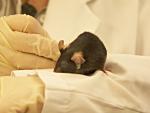 |
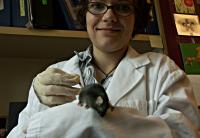 |
 |
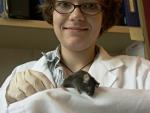 |
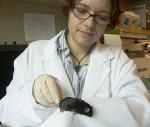 |
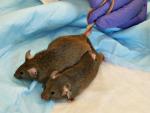 |
Click the image for a larger version.
Movies
Mouse MoviePowerPoint Animation
Use PowerPoint 2002 or better to view:Free PowerPoint Viewer for Windows
Powerpoint animation of reactive oxygen generation from the mitochondrial electron transport chain (ETC)
Slide 1: Powerpoint animation of reactive oxygen generation from the mitochondrial electron transport chain (ETC).
1st mouse click: electron transport with generation of a proton gradient and production of ATP, with oxygen utilized as the final electron acceptor.
2nd mouse click: escape of free electrons from complex I and III of the electron transport chain, with production of superoxide.
3rd mouse click Superoxide dismutase catalyzes the conversion of superoxide to hydrogen peroxide. The enzyme catalase removes hydrogen peroxide, with production of water.
4th mouse click: If hydrogen peroxide is not eliminated, it can generate the highly reactive hydroxyl radical (iron accelerates this process via the Fenton reaction). Hydroxyl radicals will damage cellular macromolecules, including components of the electron transport chain.
Slide 2: Mitochondrial function and reactive oxygen (ROS) damage.
1st mouse click: Mitochondrial ROS can damage mitochondrial DNA, mitochondrial proteins and the mitochondrial permeability transition pore (MPTP). Aconitase (within the Krebs cycle) and proteins with in ETC complex I, II and III have iron-sulfur centers which make them particularly sensitive to ROS damage. Opening of the MPTP secondary to ROS damage can induce cellular apoptosis.
2nd mouse click: mitochondrial DNA codes for important components of the electron transport chain. ROS damage to mitochondrial DNA can result in mutated proteins, which may be less functional and result in greater leakage of electrons from the ETC, producing further DNA damage, etc. A vicious circle, or "error catastrophe" may result.